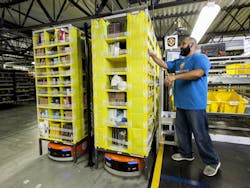Sincerely Stefanie: Defining Safety Culture
Safety culture often is used as a buzzword or phrase.
What really defines safety culture? In actuality, safety should be part of a company’s culture, and the two shouldn’t be mutually exclusive. Everyone from C-suite to HR to professionals on down should have the same core vision, values and beliefs when it comes to maintaining a safe workplace. It should be integrated into a company’s mission and everyday operations.
Carletta Ooton, Amazon’s vice president of Health, Safety, Sustainability, Security and Compliance, spoke to EHS Today’s Safety Leadership Conference attendees about how the world’s largest online retailer is changing the “mischaracterization” of the company in the media through changing the way its associates perceive Amazon’s safety culture.
“We decided that we needed to figure out what our associates really think about safety,” she explained. “We needed to innovate how to measure our safety culture on an ongoing basis by understanding both the safety sentiment of our associates and our frontline leaders at our sites around the world.”
Ooton stated that in her five-year tenure at the company safety has shifted from a talking point to being evident in everything Amazon associates do across their global fulfillment network. One big driver to this is Ooton’s in-house development of the Safety Leadership Index (SLI), a measurement of both Amazon leaders’ and associates’ perceptions of site leadership’s focus on creating a safe workplace.
“It’s extraordinarily thoughtful, extremely simple and it’s at the heart of what we want to know,” Ooton said.
SLI is essentially a barometer of what is working and not working on a site-by-site, worker-by-worker basis. Surveys sent to employees ask questions such as:
• Even if it is really busy, does your manager make time for safety?
• Do you feel you work in a safe workplace?
• Do you feel you have everything you need to perform your job safely?
• Does the training match real-world expectations?
• Do you feel encouraged to report safety issues?
• Does your manager care about the safety of you and your team?
Each of these questions is followed by these possible responses: never, sometimes, often or always. Once these responses are gathered, further analysis allows Ooton and her team to determine areas of focus and changes in current initiatives. In 2018, more than 19,000 action plans were implemented as a result of data auditing and additional worker input.
Ooton’s efforts to change Amazon’s culture parallels with ISO 45001, which requires involvement from leadership and all workers.
The new international standard is going to be the basis for all safety management systems implemented globally, not because companies want to, but because customers will demand it, Ed Foulke, Fisher & Phillips partner and former head of OSHA, told SLC attendees in a packed session.
The delicate dance between safety and the bottom line is finally coming to an end as the new standard directs top management of companies to implement systems company-wide.
With ISO 45001, responsibility for safety is not tasked to a specific person such as a safety director. It does not specify performance criteria or mandate a specific system design, which means companies are able to use current frameworks to build a more robust, effective system. ISO 45001 assesses risks beforehand, rather than working backward after an injury has already occurred. In addition, safety leadership from all levels is required to make the model work.
“In the context of the organization, it will tell what we do, why do we live, what do we produce, and that will drive how we address risk,” said Steve Davis, lead consultant, Fisher Phillips Safety Solutions. “The management team and workers are involved in writing and implementing all of the procedures. This is not new. This is a quality management system.”
Publicly-traded companies such as Amazon should be interested in ISO 45001 certification from a public relations and sustainability perspective. The positive impact on corporate culture includes a transformation from correction-mode to prevention mode.
The standard will allow for improved efficiency and consistency of internal operations. In addition, companies seeking certification will see an increase in productivity and improved quality while achieving operational excellence.
“If we build a system that is clean and efficient enough, it will run itself. In fact, the employees will run it,” Davis said. “If safety and risk is managed well, it becomes a non-issue.”
Safety culture should no longer be thrown around as a buzzword, as new tools and systems make it easier to prove return on investment (ROI). With so much data and the roadmaps at our fingertips, safety professionals can now drive home the value of implementing a robust continuous improvement system, making it easier to go above and beyond compliance.
About the Author

Stefanie Valentic
Stefanie Valentic was formerly managing editor of EHS Today, and is currently editorial director of Waste360.
